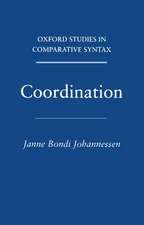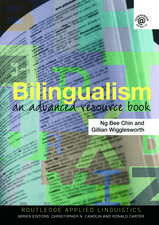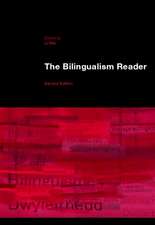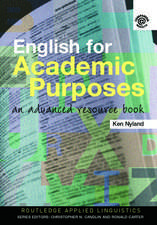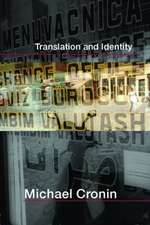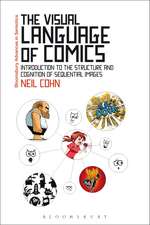Language in Education: Social Implications
Autor Rita Elaine Silver, Dr Soe Marlar Lwinen Limba Engleză Paperback – 6 noi 2013
| Toate formatele și edițiile | Preț | Express |
|---|---|---|
| Paperback (1) | 263.62 lei 3-5 săpt. | |
| Bloomsbury Publishing – 6 noi 2013 | 263.62 lei 3-5 săpt. | |
| Hardback (1) | 1006.79 lei 3-5 săpt. | |
| Bloomsbury Academic – 2014 | 1006.79 lei 3-5 săpt. |
Preț: 263.62 lei
Nou
Puncte Express: 395
Preț estimativ în valută:
50.45€ • 52.12$ • 41.99£
50.45€ • 52.12$ • 41.99£
Carte disponibilă
Livrare economică 04-18 martie
Preluare comenzi: 021 569.72.76
Specificații
ISBN-13: 9781441151810
ISBN-10: 1441151818
Pagini: 216
Dimensiuni: 156 x 234 x 18 mm
Greutate: 0.34 kg
Editura: Bloomsbury Publishing
Colecția Bloomsbury Academic
Locul publicării:London, United Kingdom
ISBN-10: 1441151818
Pagini: 216
Dimensiuni: 156 x 234 x 18 mm
Greutate: 0.34 kg
Editura: Bloomsbury Publishing
Colecția Bloomsbury Academic
Locul publicării:London, United Kingdom
Caracteristici
Covers the nature of language, language learning, language use in classrooms, oracy-literacy links, and multilingualism
Notă biografică
Rita Elaine Silver is Associate Professor at the National Institute of Education, Singapore.Soe Marlar Lwin is Assistant Professor at the National Institute of Education, Singapore.
Cuprins
1: What is the role of language in Education? Soe Marlar Lwin and Rita Elaine Silver2: What is the structure of language? Lubna Alsagoff and Chee Lick Ho3: How do we use language to make meaning? Soe Marlar Lwin and Peter Teo4: Why is there variation within a language? Anthea Fraser Gupta5: How do children learn language? Theres Grüter6: How do speaking and writing support each other? Christine C. M. Goh and Paul Doyle 7: How is language used for learning? Rita Elaine Silver, A. R. Raslinda and Galyna Kogut8: How do people use different languages differently? Manka M. Varghese and Rukmini Becerra Lubies9: How does policy influence language in education? Francis M. HultReferencesGlossary
Recenzii
The book contains numerous commendable features, among which is the inclusion of a wide range of essential topics, all covered in a substantive manner, yet one that is easily accessible to the non-specialist ... The overall appeal of this book is also enhanced by the many thought-provoking questions and suggested additional references, including online sources found at chapter endings ... In sum, this is an excellent collection of readings.
Rita Silver and Sor Marlar Lwin have produced an invaluable resource for learning, reflection and enrichment about the infinitely complex and fascinating dimensions of language in education. Progressing by stages from the ubiquitous presence of language in education, through to structure, meaning and variation within languages, to children's cognitive and social processes of acquisition, and then to social varieties, communication contexts and policy realities, they traverse the full lifecycle of language in education. This is a convincing and ordered contribution to the field of language in education for teachers, parents and students.
This inspiring, informative and unpretentious book provides an excellent introduction to the field. Topical and highly readable, the international team of contributors has produced a text which will appeal to a broad range of readers interested in finding out more about how language is used, taught and learned in educational settings.
This edited collection brings together a number of chapters and suggested resources that will prove helpful to students and practising teachers alike.It reflects the linguistic and social aspects of language, its form and use, for educational settings, comprehensively and yet in an extremely accessible way.
This is a well-written, scholarly and informative book, which brings together key issues related to language and education, viewing language in all its social dimensions. It will be of value to students across many courses and levels of study, both undergraduate and postgraduate. It will have particular value for teachers wishing to improve their understandings of language and its role in teaching and learning.
We use language to define our world, while at the same time the social world in which we live defines our language. The structure of language and the variation we find within it depend both on the social world as well as the ways in which we create an identity for ourselves and the ways in which we build relations with others. Understanding how language both constrains our thoughts and actions and how we use language to overcome those constraints are important lessons for all educators. In each of the nine chapters in this book, the authors ask a specific question about how and why language helps or hinders, and they provide sensible answers that do not assume technical knowledge of linguistics. In so doing, the authors have made the lessons of language accessible to a wide range of readers.
This book serves as both an introductory text to those who are wanting to familiarize themselves with the important role of language in education and at the same time it provides an important contribution to a greater understanding of perspectives on language structure, language variation and language function. Often when students begin to study education subjects with a view to being a classroom teacher it takes a long time for them to appreciate the role of language in teaching - this book brings into immediate focus the importance of language in education.
The reviewed book provides an excellent introduction to the relationship between language and education, enhanced by its emphasis on the social aspects of language, beyond the purely grammatical. It also stands out for its excellent selection of topics and clarity in dealing with them. [...] This book can be a great instrument for present and future educators in the field of linguistics.
Rita Silver and Sor Marlar Lwin have produced an invaluable resource for learning, reflection and enrichment about the infinitely complex and fascinating dimensions of language in education. Progressing by stages from the ubiquitous presence of language in education, through to structure, meaning and variation within languages, to children's cognitive and social processes of acquisition, and then to social varieties, communication contexts and policy realities, they traverse the full lifecycle of language in education. This is a convincing and ordered contribution to the field of language in education for teachers, parents and students.
This inspiring, informative and unpretentious book provides an excellent introduction to the field. Topical and highly readable, the international team of contributors has produced a text which will appeal to a broad range of readers interested in finding out more about how language is used, taught and learned in educational settings.
This edited collection brings together a number of chapters and suggested resources that will prove helpful to students and practising teachers alike.It reflects the linguistic and social aspects of language, its form and use, for educational settings, comprehensively and yet in an extremely accessible way.
This is a well-written, scholarly and informative book, which brings together key issues related to language and education, viewing language in all its social dimensions. It will be of value to students across many courses and levels of study, both undergraduate and postgraduate. It will have particular value for teachers wishing to improve their understandings of language and its role in teaching and learning.
We use language to define our world, while at the same time the social world in which we live defines our language. The structure of language and the variation we find within it depend both on the social world as well as the ways in which we create an identity for ourselves and the ways in which we build relations with others. Understanding how language both constrains our thoughts and actions and how we use language to overcome those constraints are important lessons for all educators. In each of the nine chapters in this book, the authors ask a specific question about how and why language helps or hinders, and they provide sensible answers that do not assume technical knowledge of linguistics. In so doing, the authors have made the lessons of language accessible to a wide range of readers.
This book serves as both an introductory text to those who are wanting to familiarize themselves with the important role of language in education and at the same time it provides an important contribution to a greater understanding of perspectives on language structure, language variation and language function. Often when students begin to study education subjects with a view to being a classroom teacher it takes a long time for them to appreciate the role of language in teaching - this book brings into immediate focus the importance of language in education.
The reviewed book provides an excellent introduction to the relationship between language and education, enhanced by its emphasis on the social aspects of language, beyond the purely grammatical. It also stands out for its excellent selection of topics and clarity in dealing with them. [...] This book can be a great instrument for present and future educators in the field of linguistics.

